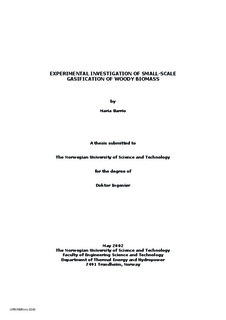| dc.contributor.author | Barrio, Maria | nb_NO |
| dc.date.accessioned | 2014-12-19T11:25:11Z | |
| dc.date.available | 2014-12-19T11:25:11Z | |
| dc.date.created | 2002-05-07 | nb_NO |
| dc.date.issued | 2002 | nb_NO |
| dc.identifier | 126378 | nb_NO |
| dc.identifier.isbn | 82-471-5435-8 | nb_NO |
| dc.identifier.uri | http://hdl.handle.net/11250/231338 | |
| dc.description.abstract | A small-scale stratified downdraft gasifier has been built and operated under stable conditions using wood pellets as fuel and air as gasification agent. The problems observed during the preliminary experiments have been described and explained; they are mainly related to the stability of the process. The stable operation of the gasifier has been characterised by the gas composition and the product gas tar and particle content. The biomass feeding rate has varied between 4,5 and 6,5 kg/h. The CO content of the product gas (23-26 % vol.) is higher than in similar gasifiers and the H2 content has been found to vary between 14 and 16 % vol. The tar content in the product gas (ca. 3 g/Nm3) is rather high compared with similar gasifiers. The temperature profile, together with other relevant parameters like the air-excess ratio, the air to fuel ratio and gas to fuel ratio have been calculated. The experiments show that the air excess ratio is rather constant, varying between 0,25 and 0,3. Experiments have been conducted with a gas engine using mixtures of CH4, CO, H2, CO2 and N2 as a fuel. NOx and CO emissions are analysed. The char gasification process has been studied in detail by means of Thermogravimetric Analysis. The study comprises the chemical kinetics of the gasification reactions of wood char in CO2 and H2O, including the inhibition effect of CO and H2. A kinetic model based on Langmuir-Hinshelwood kinetics has been found which relates the mass loss rate to the temperature, gas composition and degree of conversion for each reaction. The ratio CO/CO2 has been found to be a relevant parameter for reactivity. The gasification experiments in mixtures of CO2 and H2O give reasons to believe that the rate of desorption for the complex C(O) varies depending on the gas mixture surrounding the char. It has been found that if the experimental data are obtained from separate H2O/N2 and CO2/N2 experiments, the reactivity of the char in mixtures of CO2 and H2O can be fairly predicted. | nb_NO |
| dc.language | eng | nb_NO |
| dc.publisher | Fakultet for ingeniørvitenskap og teknologi | nb_NO |
| dc.relation.ispartofseries | Dr. ingeniøravhandling, 0809-103X; 2002:40 | nb_NO |
| dc.relation.haspart | Barrio, M; Fossum, M; Hustad, J.E. A small-scale stratified downdraft gasifier coupled to a gas engine for combined heat and power production.. Progress in Thermochemical Biomass Conversion. 1, 2001. | nb_NO |
| dc.relation.haspart | Barrio, M; Fossum, M; Fossum, M. Operational Characteristics of a Small-Scale Stratified Downdraft Gasifier. Technologies and combustion for a clean environment Sixth International Conference. 3, 2001. | nb_NO |
| dc.relation.haspart | Fossum, M; Barrio, M; Hustad, J.E. Operational Experiences from a Small-scale Biomass Gasifier coupled to a Gas Engine. First Biennial Meeting, 2001. | nb_NO |
| dc.relation.haspart | Barrio, M; Gøbel, B; Risnes, H; Henriksen, U; Hustad, J.E; Sørensen, L.H. Steam gasification of wood char and the effect of hydrogen inhibition on the chemical kinetics. Progress in Thermochemical Biomass Conversion. 1, 2001. | nb_NO |
| dc.relation.haspart | Barrio, M; Hustad, J.E. CO2 gasification of birch char and the effect of CO inhibition on the calculation of chemical kinetics.. Progress in Thermochemical Biomass Conversion. 1, 2001. | nb_NO |
| dc.title | Experimental investigation of small-scale gasification ofwoody biomass | nb_NO |
| dc.type | Doctoral thesis | nb_NO |
| dc.source.pagenumber | 222 | nb_NO |
| dc.contributor.department | Norges teknisk-naturvitenskapelige universitet, Fakultet for ingeniørvitenskap og teknologi | nb_NO |
| dc.description.degree | dr.ing. | nb_NO |
| dc.description.degree | dr.ing. | en_GB |
